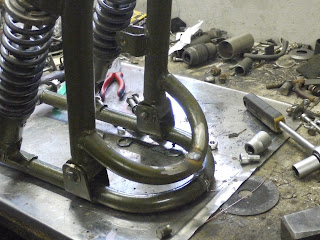Why would you want an earles fork? With the pre-dominance of the telescopic fork on motorcycles, all other (possible) front ends sport an aura of esoterical strangeness, except maybe for BMWs copy of the Hossack front end called Tele- or Paralever and a few scooters which run some sort of leading link forks. That said, on sidecars earles forks aren't uncommon as they have a few major advantages:
- They are more durable as they can cope better with the sideloads. Unlike telescopic forks there are no fork-bushings to wear out from the sideload.
- Due to changed leverage they are a lot easier to steer.
- They can be tuned to suit the weight of the vehicle quite easily.
- Changes of brake calipers or disk-sizes are easy as you'll only have to fabricate new brake-carrierplates.
It's hard to see in the picture above, but yes, the two legs are off by about five mm. Oh and also note the tapered ends of the fork legs, they'll guarantee some extra fun towards the end of this post.
As mentioned before, after a bit of cutting it all slots into place (quite) nicely.
Now the Dneprs run on three interchangeable wheels, which is dead-cool in a sidecar, if you ask me. Unfortunately the XS doesn't and so a bushing on the right side is needed. (My first axle didn't have it and it lead to the front wheelbearings rusting solidly onto the axle... and additionally it reinforces the front end dramatically.)
It was meant to be a push fit, but it came out a bit sloppier than I wanted, so a bit of the electric hot glue was due.
That's not looking too bad at all, is it? Guess we'll just weld it up and call it a day then... (You have the right to a smug grin and a little chuckle as you surely know where this is going!)
All welds of course reinforced with some roundstock on the inside. You wouldn't want to just butt-weld two pieces of tube onto each other in such a high-stress situation.
Remember the tapered ends of the fork legs? Well that taper runs at a five degree angle and now it surely would be more than boring to just cut the ends of, knock up two extensions on the lathe and weld them in. Let's do this a little overcomplicated and challenge ourselves.
Luckily the fork legs are tapped M28x1 on the inside, so the tapered plugs are held in place with some endcaps. Works brilliantly.
Unfortunately, this was when sloppyness reared its ugly head and it became apparent, that I have to cut the forks apart again to have them sit in the triples without being under constant tension.
















Good work fella! ( as usual Greg, we are not worthy! ) just be careful when you cut it, don't want to end up with a black-eye when it springs apart now do we! Glad you are turning up some slugs rather than butting up the tube-ends, do you do your own welding? What set do you have? Mig or tig? I'm an apprentice trained pipe fitter/welder so can arc anything but when it comes to presicion, high-stress welding I bottle it, tack up the work and leave it to the experts..........
ReplyDeleteTrained in Mig and Tig welding and that's (by no coincidence) also the two sets I have in my shop. I am not exactly great with arc, so all my simple fab-work I do with MIG, very, very rarely that I do some arc welding, which then is just some really weird electrodes for welding cast iron stuff and that sort of thing.
DeleteYeah those slugs came out nicely in the end, but I'll shorten them a bit on the lathe, so that the remaining metal is a bit thicker and then TIG them to the fork legs.
For my welding equipment, I run a Chinese 250A MIG/Mag inverter, which is the dog's danglies as it's only slightly bigger than the spool and for a TIG set a 200A Stahlwerk AC/DC set, which is nothing fancy but gets the job done nicely.
This comment has been removed by a blog administrator.
ReplyDelete